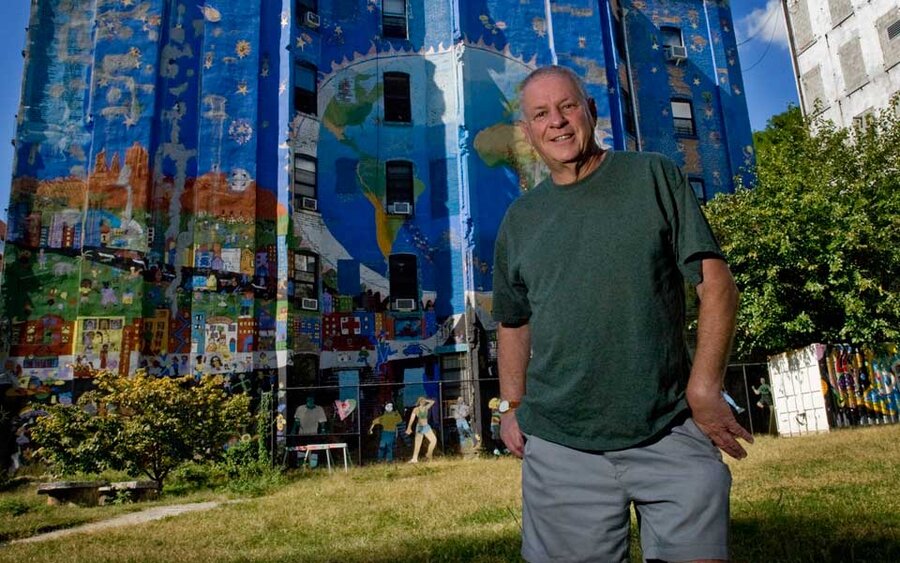The New York Nobody Knows
Loading...
A native New Yorker, William Helmreich spent his youth strolling the city’s streets. But as an adult and sociology professor at the City University of New York, Helmreich devised a more formal plan – to walk 6,000 miles, covering every block in all five boroughs over the course of four years.
Monitor books editor Marjorie Kehe recently talked with Helmreich about his long walk, the city he loves, and the book he wrote about both: The New York Nobody Knows. Here are excerpts from their conversation.
Q: You note abundant evidence of a “New York renaissance.” To what do you attribute the city’s rebirth?
The two major sources of the city’s revitalization have been gentrification and immigration. The immigrants have brought new life to the city. While immigration has been going on in New York ever since the city existed, the diversity of immigrants is different today. [Once] we had people coming from every corner of Eastern and Western Europe. Now we have people coming from Africa, Asia, and Latin America. Most of the immigrants who come here work hard, even the undocumented. Maybe especially the undocumented.
Q: What about gentrification? How has that changed the city?
It’s huge. We’ve had hundreds of thousands of people streaming into our city from all over the country and back into the city from the surrounding suburbs. They’ve revitalized the city, turned neighborhoods that were ghost towns into vibrant cultural centers. They’ve stimulated the economy because these are middle- and upper-class people of means. But on the other hand, a world-class city also has an obligation to its needier citizens, and a lot of people have been displaced by gentrification.
Q: Despite its tolerance, you say that New York is actually one of the most racially segregated cities in the US. Is that ever going to change?
I’m not sure that people want it to change. When [minorities] were protesting to move into exclusively white neighborhoods, what they were protesting [for] was the right to move in. Once you said, “You can live anywhere you like, the only color we care about is green” – what happens if people don’t want to go there?
There are people who welcome diversity. But there are also those who don’t. What you’ve got here is freedom to choose. It’s up to the people. New York remains one of the most segregated cities because there’s enough mass to create self-contained communities and people take pleasure and pride in living in those communities.
Q: The gentrification of Brooklyn is a done deal. What will be the next great neighborhood?
The Bronx is going to gentrify. That’s the last frontier. I’m high on the Bronx because it’s only 15 to 20 minutes from the center of the city and is served by five or six subway lines.
Q: What surprised you on your walks?
The way that people who are at odds with each other in their home country meet here on neutral turf. You have Indians and Pakistanis living together in the same neighborhood and getting along. You have Jews and Palestinians owning stores on Coney Island Avenue in Brooklyn and living in peace and finding common shared values such as modest dress among women and religious piety. You have Haitians and Dominicans getting along amicably. People told me: “There’s no time for [conflict] here; here we have other priorities.”
Some things weren’t exactly surprises but were emphasized to me. One was how many beautiful parks we have in New York, including Pelham Bay Park, 150 blocks long and 2-1/2 times the size of Central Park. The city’s most beautiful waterfall is at 180th Street and Boston Road. There is also the $5 million Chinese Scholar’s Garden on Staten Island and the Jamaica Bay Wildlife Refuge.
The other thing was the friendliness of New Yorkers. Almost no one refused to talk to me.
Q: What about the future of New York? What’s your greatest concern?
My biggest concern is [newly elected Mayor Bill] de Blasio. Although I agree with a lot of his philosophy, I’m concerned that he might be goaded into taking it too far too fast. I think New York needs a corrective. The city needs to find more affordable housing for its people. It needs to pay more attention to its needier citizens. However, it has to do so without scaring people away. New York is a liberal city, yet it is a city that has had Republican governance for the past 20 years. De Blasio can’t stray too far to the left, even as other [New York politicians] can’t stray too far to the right.







